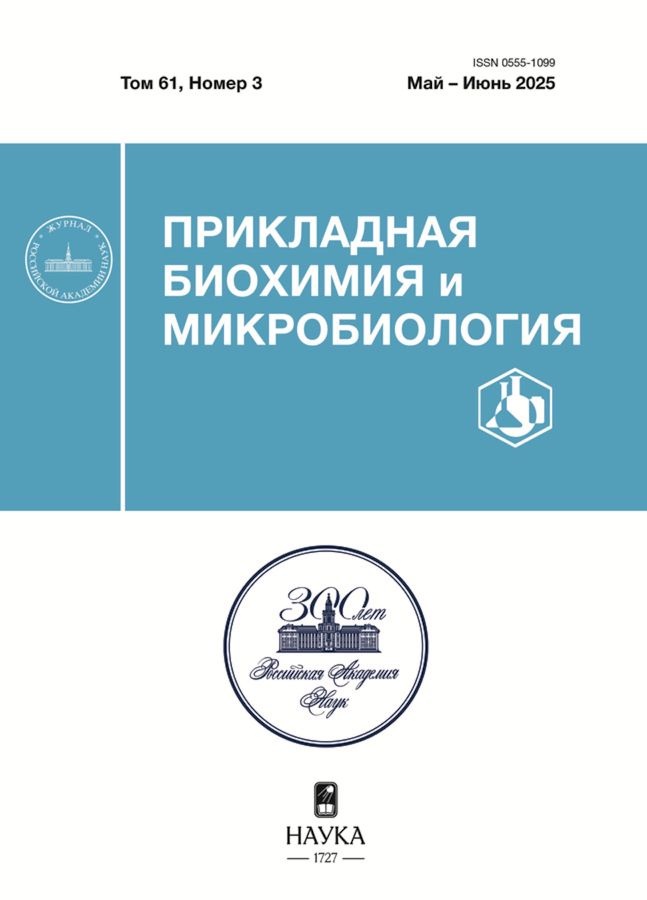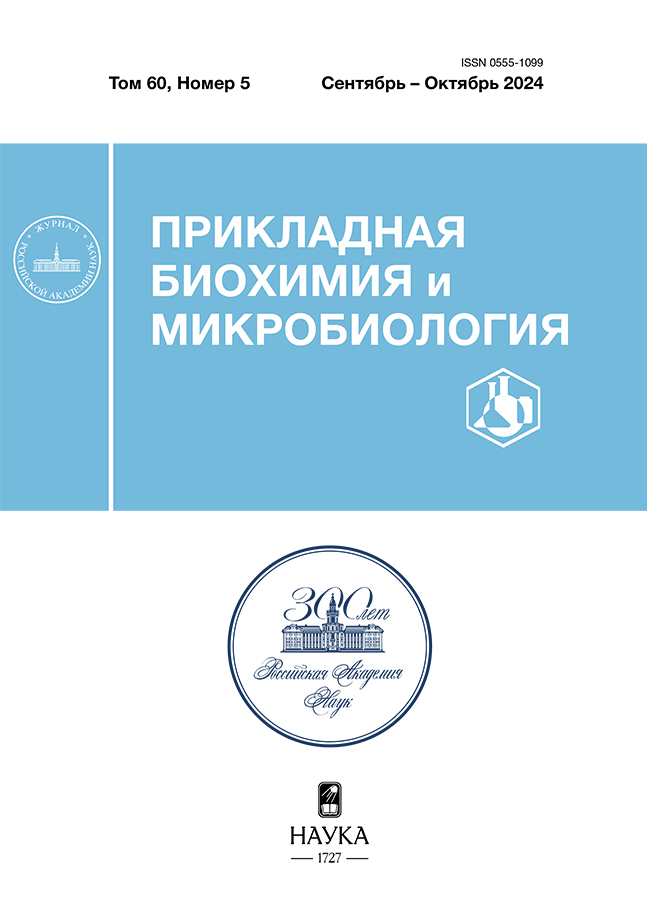Engineering of recombinant endolysin LysSi3 to increase its antibacterial properties
- Authors: Antonova N.P.1, Grigoriev I.V.1, Lendel A.M.1, Usacheva O.V.1, Klimova A.A.1, Usachev E.V.1, Gushchin V.A.1,2, Vasina D.V.1
-
Affiliations:
- N.F. Gamaleya National Research Centre for Epidemiology and Microbiology, Ministry of Health of the Russian Federation
- Lomonosov Moscow State University
- Issue: Vol 60, No 5 (2024)
- Pages: 455-464
- Section: Articles
- URL: https://cardiosomatics.ru/0555-1099/article/view/681853
- DOI: https://doi.org/10.31857/S0555109924050033
- EDN: https://elibrary.ru/QTWCJY
- ID: 681853
Cite item
Abstract
The potential of new genetically modified recombinant endolysins as antimicrobial agents against Gram-negative bacteria was investigated. A series of enzymes based on LysSi3 lysozyme-like muramidase were obtained by modifying its sequence with antimicrobial peptides of different families and recombinant expression in E. coli was demonstrated. Modification of LysSi3 resulted in increased bacteriolytic activity against the model isolate of A. baumannii and higher kinetics rate compared to the native enzyme. The cytotoxic properties of new engineered lysins were investigated with the HEK293 and HaCaT cell lines and it was shown that modification of LysSi3 with antimicrobial peptides does not significantly increase the toxic properties in vitro.
Full Text
About the authors
N. P. Antonova
N.F. Gamaleya National Research Centre for Epidemiology and Microbiology, Ministry of Health of the Russian Federation
Email: d.v.vasina@gmail.com
Russian Federation, Moscow, 123098
I. V. Grigoriev
N.F. Gamaleya National Research Centre for Epidemiology and Microbiology, Ministry of Health of the Russian Federation
Email: d.v.vasina@gmail.com
Russian Federation, Moscow, 123098
A. M. Lendel
N.F. Gamaleya National Research Centre for Epidemiology and Microbiology, Ministry of Health of the Russian Federation
Email: d.v.vasina@gmail.com
Russian Federation, Moscow, 123098
O. V. Usacheva
N.F. Gamaleya National Research Centre for Epidemiology and Microbiology, Ministry of Health of the Russian Federation
Email: d.v.vasina@gmail.com
Russian Federation, Moscow, 123098
A. A. Klimova
N.F. Gamaleya National Research Centre for Epidemiology and Microbiology, Ministry of Health of the Russian Federation
Email: d.v.vasina@gmail.com
Russian Federation, Moscow, 123098
E. V. Usachev
N.F. Gamaleya National Research Centre for Epidemiology and Microbiology, Ministry of Health of the Russian Federation
Email: d.v.vasina@gmail.com
Russian Federation, Moscow, 123098
V. A. Gushchin
N.F. Gamaleya National Research Centre for Epidemiology and Microbiology, Ministry of Health of the Russian Federation; Lomonosov Moscow State University
Email: d.v.vasina@gmail.com
Russian Federation, Moscow, 123098; Moscow, 119991
D. V. Vasina
N.F. Gamaleya National Research Centre for Epidemiology and Microbiology, Ministry of Health of the Russian Federation
Author for correspondence.
Email: d.v.vasina@gmail.com
Russian Federation, Moscow, 123098
References
- Murray E., Draper L.A., Ross R.P., Hill C. // Viruses. 2021. V. 13. № 4. P. 680. https://doi.org/10.3390/v13040680
- Oliveira H., Thiagarajan V., Walmagh M., Sillankorva S., Lavigne R., Neves-Petersen M.T. et al. // PLoS One. 2014. V. 9. № 10. P. e108376. https://doi.org/10.1371/journal.pone.0108376
- Heselpoth R.D., Euler C.W., Schuch R., Fischetti V.A. // Antimicrob. Agents Chemother. 2019. V. 63. № 6. https://doi.org/10.1128/AAC.00342-19
- Yan G., Liu J., Ma Q., Zhu R., Guo Z., Gao C. et al. // Antonie van Leeuwenhoek. 2017. V. 110. № 12. P. 1627–1635. https://doi.org/10.1007/s10482-017-0912-9
- Gutiérrez D., Briers Y. // Curr. Opin. Biotechnol. 2021. V. 68. P. 15–22. https://doi.org/10.1016/j.copbio.2020.08.014
- Ma Q., Guo Z., Gao C., Zhu R., Wang S., Yu L. et al. // Antonie Van Leeuwenhoek. 2017. V. 110. № 3. P. 347–355. https://doi.org/10.1007/s10482-016-0806-2
- Gerstmans H., Criel B., Briers Y. // Biotechnol. Adv. 2018. V. 36. № 3. P. 624–640. https://doi.org/10.1016/j.biotechadv.2017.12.009
- Antonova N.P., Vasina D.V., Rubalsky E.O., Fursov M.V., Savinova A.S., Grigoriev I.V., Usachev E.V. et al. // Biomolecules. 2020. V. 10. № 3. P. 440. https://doi.org/10.3390/biom10030440
- Yang H., Wang M., Yu J., Wei H. // Front. Microbiol. 2015. https://doi.org/10.3389/fmicb.2015.01471
- Briers Y., Walmagh M., Van Puyenbroeck V., Cornelissen A., Cenens W., Aertsen A. // mBio. 2014. V. 5. № 4. https://doi.org/10.1128/mBio.01379-14
- Yan G., Yang R., Fan K., Dong H., Gao C., Wang S. et al. // AMB Express. 2019. V. 9. № 1. https://doi.org/10.1186/s13568-019-0838-x
- Pirtskhalava M., Amstrong A.A., Grigolava M., Chubinidze M., Alimbarashvili E., Vishnepolsky B. et al. // Nucleic Acids Res. 2021. V. 49. № D1. P. D288–D297. https://doi.org/10.1093/nar/gkaa991
- Vasina D.V., Antonova N.P., Grigoriev I.V., Yakimakha V.S., Lendel A.M., Nikiforova M.A., Pochtovyi A.A. et al. // Front. Microbiol. 2021. V. 12. P. 3033. https://doi.org/10.3389/fmicb.2021.748718
- Vasina D.V., Antonova N.P., Shidlovskaya E.V., Kuznetsova N.A., Grishin A.V., Akoulina E.A. et al. // Gels. 2024. V. 10. № 1. https://doi.org/10.3390/gels10010060
- Ma Q., Guo Z., Gao C., Zhu R., Wang S., Yu L. et al. // Antonie van Leeuwenhoek. 2017. V. 110. № 3. P. 347–355. https://doi.org/10.1007/s10482-016-0806-2
- Gerstmans H., Grimon D., Gutiérrez D., Lood C., Rodríguez A., van Noort V. et al. // Sci. Adv. 2020. V. 6. № 23. https://doi.org/10.1126/sciadv.aaz1136
- Silvestro L., Weiser J.N., Axelsen P.H. // Antimicrob. Agents Chemother. 2000. V. 44. № 3. P. 602. https://doi.org/10.1128/AAC.44.3.602-607.2000
- Chen X., Liu M., Zhang P., Leung S.S.Y., Xia J. // ACS Infect. Dis. 2021. V. 7. № 8. P. 2192–2204. https://doi.org/10.1021/acsinfecdis.1c00222
- Islam M.M., Kim D., Kim K., Park S.J., Akter S., Kim J. et al. // Front. Microbiol. 2022. V. 13. P. 988522. https://doi.org/10.3389/fmicb.2022.988522
- Lim J., Hong J., Jung Y., Ha J., Kim H., Myung H. et al. // J. Microbiol. Biotechnol. 2022. V. 32. № 6. P. 816–823. https://doi.org/10.4014/jmb.2205.05009
- Zolin G.V.S., Fonseca F.H.D., Zambom C.R., Garrido S.S. // Biomolecules. 2021. V. 11. № 8. P. 1209. https://doi.org/10.3390/biom11081209
- Helmerhorst E.J., van’t Hof W., Breeuwer P., Veerman E.C., Abee T., Troxler R.F. et al. // J. Biol. Chem. 2001. V. 276. № 8. P. 5643–5649. https://doi.org/10.1074/jbc.M008229200
- Kavanagh K., Dowd S., Kavanagh K. // J. Pharm. Pharmacol. 2010. V. 56. № 3. P. 285–289. https://doi.org/10.1211/0022357022971.
- Puri S., Edgerton M. // Eukaryot. Cell. 2014. V. 13. № 8. P. 958–964. https://doi.org/10.1128/EC.00095-14
- Sajjan U.S., Tran L.T., Sole N., Rovaldi C., Akiyama A., Friden P.M. et al. // Antimicrob. Agents Chemother. 2001. V. 45. № 12. P. 3437–3444. https://doi.org/10.1128/AAC.45.12.3437-3444.2001
- De Smet K., Contreras R. // Biotechnol. Lett. 2005. V. 27. № 18. P. 1337–1347. https://doi.org/10.1007/s10529-005-0936-5
- Wang J., Chou S., Xu L., Zhu X., Dong N., Shan A., et al. // Sci. Rep. 2015. V. 5. № 1. P. 1–19. https://doi.org/10.1038/srep15963
- Oliveira H., São-José C., Azeredo J. // Viruses. 2018. V. 10. № 6. https://doi.org/10.3390/v10060292
- Kudinova A., Grishin A., Grunina T., Poponova M., Bulygina I., Gromova M. et al. // Pathogens. 2023. V. 12. № 2. P. 177. https://doi.org/10.3390/pathogens12020177
- de Pontes J.T.C., Toledo Borges A.B., Roque-Borda C.A., Pavan F.R. // Pharmaceutics. 2022. V. 14. № 3. https://doi.org/10.3390/pharmaceutics14030642
- Huan Y., Kong Q., Mou H., Yi H. // Front. Microbiol. 2020. V. 11. https://doi.org/10.3389/fmicb.2020.582779
- Welling M.M., Brouwer C.P., van’t Hof W., Veerman E.C., Amerongen A.V. et al. // Antimicrob. Agents Chemother. 2007. V. 51. № 9. P. 3416–3419. https://doi.org/10.1128/AAC.00196-07
Supplementary files














